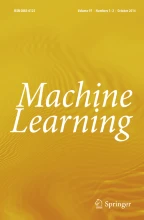Abstract
Bagging and boosting are methods that generate a diverse ensemble of classifiers by manipulating the training data given to a “base” learning algorithm. Breiman has pointed out that they rely for their effectiveness on the instability of the base learning algorithm. An alternative approach to generating an ensemble is to randomize the internal decisions made by the base algorithm. This general approach has been studied previously by Ali and Pazzani and by Dietterich and Kong. This paper compares the effectiveness of randomization, bagging, and boosting for improving the performance of the decision-tree algorithm C4.5. The experiments show that in situations with little or no classification noise, randomization is competitive with (and perhaps slightly superior to) bagging but not as accurate as boosting. In situations with substantial classification noise, bagging is much better than boosting, and sometimes better than randomization.
Article PDF
Similar content being viewed by others
Explore related subjects
Discover the latest articles, news and stories from top researchers in related subjects.Avoid common mistakes on your manuscript.
References
Ali, K. M. (1995).Acomparison of methods for learning and combining evidence from multiple models. Technical Report 95–47, Department of Information and Computer Science, University of California, Irvine.
Ali, K. M. & Pazzani, M. J. (1996). Error reduction through learning multiple descriptions. Machine Learning, 24(3), 173–202.
Bauer, E. & Kohavi, R. (1999). An empirical comparison of voting classification algorithms: Bagging, boosting, and variants. Machine Learning, 36(1/2), 105–139.
Breiman, L. (1994). Heuristics of instability and stabilization in model selection. Technical Report 416, Department of Statistics, University of California, Berkeley, CA.
Breiman, L. (1996a). Bagging predictors. Machine Learning, 24(2), 123–140.
Breiman, L. (1996b). Bias, variance, and arcing classifiers. Technical Report 460, Department of Statistics, University of California, Berkeley, CA.
Dietterich, T. G. (1998). Approximate statistical tests for comparing supervised classification learning algorithms. Neural Computation, 10(7), 1895–1924.
Dietterich, T. G. & Kong, E. B. (1995). Machine learning bias, statistical bias, and statistical variance of decision tree algorithms.Technical Report, Department of Computer Science, Oregon State University, Corvallis, Oregon. Available from ftp://ftp.cs.orst.edu/pub/tgd/papers/tr-bias.ps.gz.
Freund, Y. & Schapire, R. E. (1996). Experiments with a new boosting algorithm. In Proc. 13th International Conference on Machine Learning (pp. 148–146). Morgan Kaufmann.
Kohavi, R. & Kunz, C. (1997). Option decision trees with majority votes. In Proceedings of the Fourteenth International Conference on Machine Learning (pp. 161–169). San Francisco, CA: Morgan Kaufman.
Kohavi, R., Sommerfield, D., & Dougherty, J. (1997). Data mining using MLC++, a machine learning library in C++. International Journal on Artificial Intelligence Tools, 6(4), 537–566.
Maclin, R. & Opitz, D. (1997). An empirical evaluation of bagging and boosting. In Proceedings of the Fourteenth National Conference on Artificial Intelligence (pp. 546–551). Cambridge, MA: AAAI Press/MIT Press.
Margineantu, D. D. & Dietterich, T. G. (1997). Pruning adaptive boosting. In Proc. 14th International Conference on Machine Learning (pp. 211–218). Morgan Kaufmann.
Merz, C. J. & Murphy, P. M. (1996). UCI repository of machine learning databases. http://www.ics.uci.edu/∼mlearn/MLRepository.html.
Quinlan, J. R. (1993). C4.5: Programs for empirical learning. Morgan Kaufmann, San Francisco, CA.
Quinlan, J. R. (1996). Bagging, boosting, and C4.5. In Proceedings of the Thirteenth National Conference on Artificial Intelligence (pp. 725–730). Cambridge, MA: AAAI Press/MIT Press.
Author information
Authors and Affiliations
Rights and permissions
About this article
Cite this article
Dietterich, T.G. An Experimental Comparison of Three Methods for Constructing Ensembles of Decision Trees: Bagging, Boosting, and Randomization. Machine Learning 40, 139–157 (2000). https://doi.org/10.1023/A:1007607513941
Issue Date:
DOI: https://doi.org/10.1023/A:1007607513941
